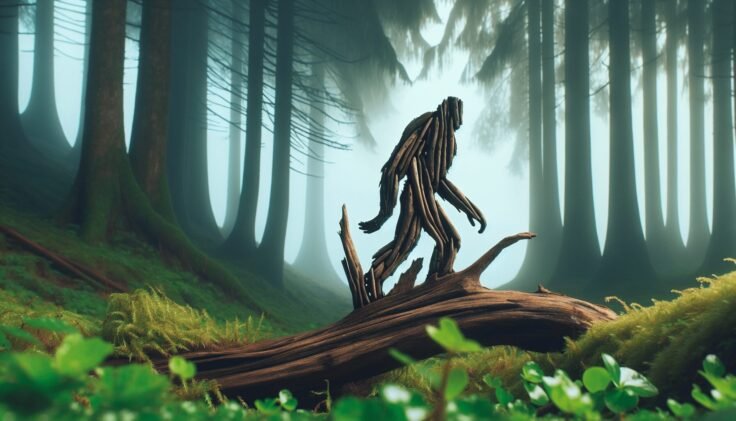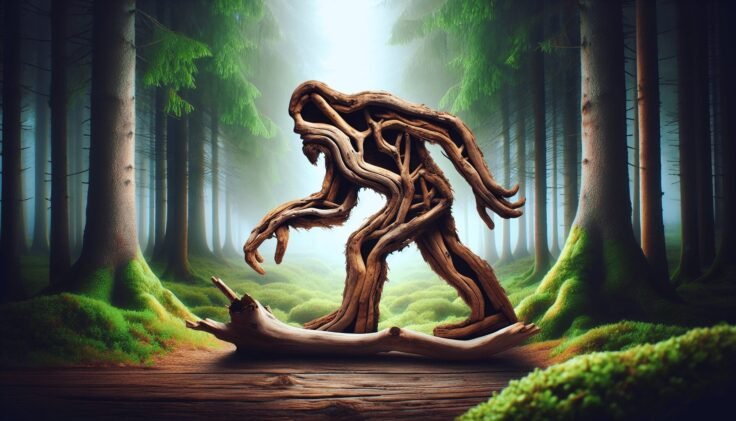Have you ever wondered if the myth of Bigfoot has more to it than just tall tales? This towering creature, often depicted as massive and elusive, has spurred countless stories and sighting claims over the years. Among the whispers and stories is a peculiar subject of interest called the “Driftwood Bigfoot.” Combining elements of natural history, peculiar geography, and folklore, this topic promises to take you through an entertaining exploration of what might just redefine some of your perceptions of myth and reality.
The Enigmatic Bigfoot Legend
Stories of Bigfoot, also known as Sasquatch, have been circulating for centuries, originating from various indigenous tribes to modern enthusiasts. This legendary creature is usually described as a large, hairy, bipedal humanoid. While skeptics see it as a product of imagination or folklore, believers ardently collect sightings and evidence attempting to prove its existence.
Bigfoot continues to capture the public’s imagination due in part to its reclusive nature and the remote areas in which it is allegedly spotted. As with many folklore creatures, the legend of Bigfoot changes slightly depending on where you are, with different regions having their own variations and accounts.
Driftwood Bigfoot: An Intriguing Twist
In the realm of Bigfoot lore, the ‘Driftwood Bigfoot’ presents a particularly captivating angle. The name conjures images of mysterious shapes and forms arising from naturally occurring driftwood found along coastlines and riversides. Driftwood, with its gnarled and twisted appearance, naturally inspires curiosity and sometimes fear, due to its spectral shape when seen from a distance.
The concept of Driftwood Bigfoot plays into the phenomenon where natural forms and optical illusions in nature are perceived as something else entirely—could driftwood be responsible for some Bigfoot sightings? This interpretation adds a playful yet thought-provoking twist to the Bigfoot discourse, blurring the lines between nature’s artistry and human imagination.

Sightings and Stories
The links between driftwood and Bigfoot sightings are not necessarily direct but rather come from anecdotal evidence and reports where distant shapes are interpreted as the mythical creature. Coastlines, often littered with driftwood, become fertile ground for such misconceptions in low light or during fleeting glimpses.
One particular account involves a witness who was camping at a beach and saw what appeared to be a hulking silhouette in the dusk light. Upon approaching cautiously the following morning, the witness discovered the figure to be an intricately shaped piece of driftwood resembling the robust outline of Bigfoot. Such stories lend themselves to the intriguing marriage between perception and illusion.
Comparing Bigfoot and Driftwood Imagery
To understand why driftwood might be mistaken for Bigfoot, comparing physical attributes could provide insight.
| Characteristics | Bigfoot | Driftwood |
|---|---|---|
| Size | Often sighted as large, up to 9 feet tall | Variable, but large pieces can seem imposing |
| Shape | Humanoid with long limbs | Twisted and gnarled, sometimes humanoid-like |
| Movement | Described as fluid and bipedal | Stationary, but viewed at different angles/positions it changes appearance |
| Texture and Color | Dense fur, typically dark brown | Rough, usually weathered, shades of gray/brown |
The table above illustrates how, under certain conditions, driftwood can mimic attributes commonly associated with Bigfoot sightings. It’s an interesting study of how human perception can be influenced by setting and context.
Driftwood as Nature’s Sculpture
Driftwood isn’t merely a tool for misunderstanding; it holds its own beauty and significance. As a piece of wood, carried by water currents and shaped by time, driftwood has storied histories of transit and transformation, making each one unique. Artists and decorators appreciate it for its aesthetic appeal, carving it into furniture, sculptures, and decorative items that enhance its natural charm.
The Journey of Driftwood
A piece of driftwood starts its life as part of a tree, gets detached often due to storms or erosion, and then embarks on a journey shaped by water bodies. This travel can last for years, with the wood being buffeted by waves and sand, stripped of bark, smoothened by grit, and possibly bleached by the sun. By the time it’s deposited on a shore, it may come to resemble intriguing or imagined shapes like the silhouette of mythical creatures.
Artistic Potential of Driftwood
Driftwood’s appearance naturally fuels the imagination. The intricate textures and unique shapes present numerous opportunities for artistic endeavors. Whether turned into an expressive piece of art or a functional object, driftwood’s journey from nature to art underscores the creative potential waiting to be unlocked within its form.

Human Perception and the Uncanny
The phenomenon of interpreting driftwood shapes as Bigfoot is deeply tied to the concept of pareidolia, where humans tend to see familiar patterns, such as faces or figures, in random stimuli. This psychological quirk plays a pivotal role in how some sightings of Bigfoot have been perceived, illustrating the interplay between our minds and the world around us.
Understanding Pareidolia
Pareidolia is our brain’s way of finding meaningful patterns in vague or ambiguous stimuli. It’s why you might see a face in the clouds or hear a hidden message in songs played backward. This cognitive bias can be especially strong in low-light conditions or when objects are only partially seen—conditions prime for mistaking driftwood for a giant, elusive creature.
Driftwood Bigfoot as Modern Mythology
The concept of the Driftwood Bigfoot can be seen as a modern addition to the realm of folklore and mythology. It demonstrates how natural phenomena can be incorporated into cultural narratives, influencing both individual stories and collective beliefs. Myths have needed raw materials, and driftwood provides a curious example of how nature itself is woven into the tapestry of human lore.
Connecting Myths Across Cultures
The idea of creatures similar to Bigfoot is not unique to one culture, and exploring how these myths arise in different societies can offer deeper insight into why the Driftwood Bigfoot holds such fascination. From the Yeti of the Himalayas to the Yowie in Australia, giant, wild humanoid creatures populate myths worldwide, often seen as guardians of natural wilderness.
Embracing the Wonder
The Driftwood Bigfoot story, part misinterpretation and part wonder, encourages an exploration of nature through a new lens. While a playful notion, it imparts respect for the environment and its capacity to inspire mystery and creativity. Whether you’re seeing the form of Bigfoot in a piece of driftwood or taking a closer look at the myths surrounding this legendary creature, there’s a sense of marvel that continues to captivate the imagination.
The Value of Exploration
By examining stories and experiences like those behind Driftwood Bigfoot, you can encourage curiosity and a deeper appreciation for the natural world. Seeing the world through this investigative lens opens the door to endless curiosity and exploration, ensuring that the landscapes you traverse are as much about imagination as they are reality.
Conclusion: The Driftwood Bigfoot Saga
So does Driftwood Bigfoot exist, or is it all just another notch in the cryptozoological bedpost? Whether it’s driftwood masquerading as legends, or an actual creature lurking as many have claimed, the story continues to intrigue. At its core, the Driftwood Bigfoot tale is a testament to the compelling blend of nature’s enigmatic forms, human perception, and age-old mythologies.
Through unraveling the mysteries and stories surrounding Driftwood Bigfoot, you connect with aspects of history, psychology, and art—a blend that honors both the mysterious and the tangible. In the interplay between reality and imagination, the Driftwood Bigfoot stands as a fascinating symbol, inviting one to think critically, yet revel in wonder.


